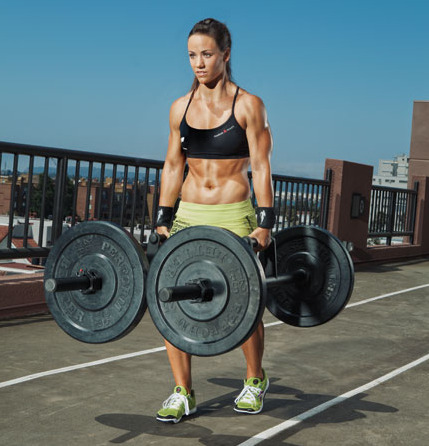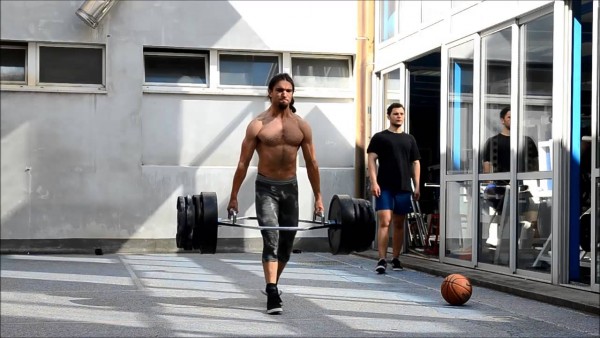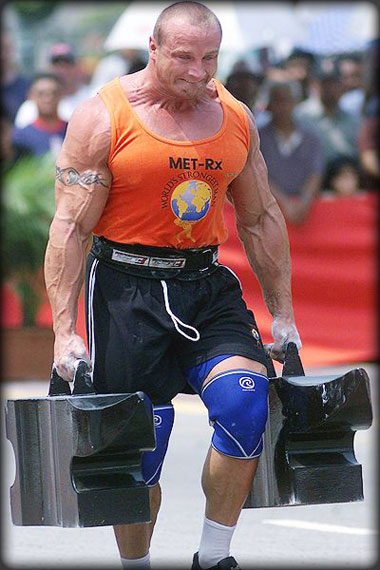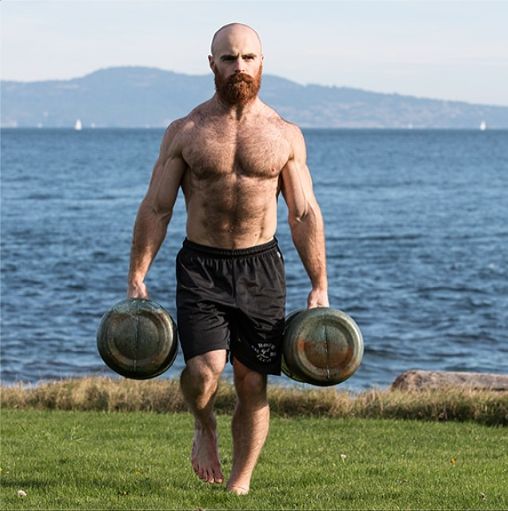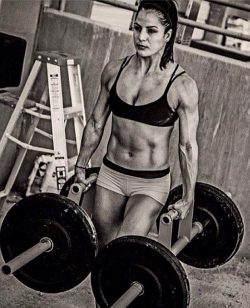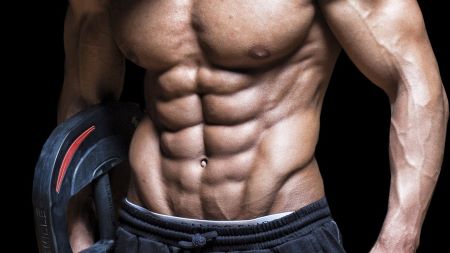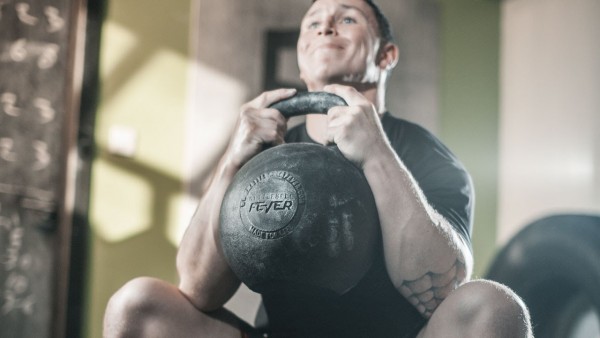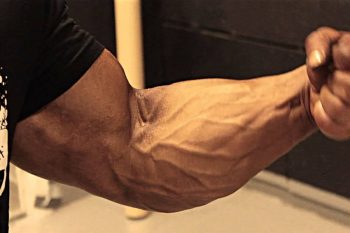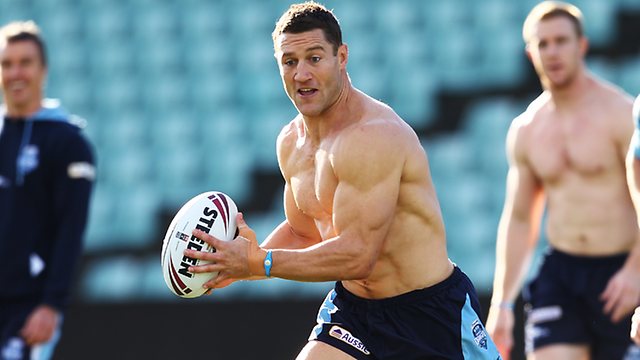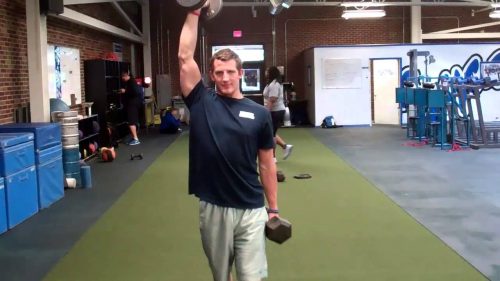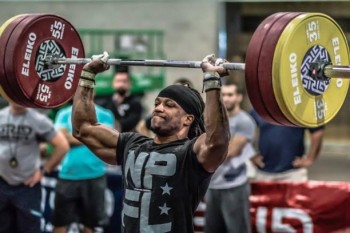In the last couple of years, the loaded carry (most notable the farmer’s carry) has exploded on the scene. Everyone from bodybuilders to Crossfitters have started to include various loaded carries into their routines and for a good reason, they work.
At my facility, we include some form of loaded carry in almost every workout, so I am used to seeing people do them. Unfortunately, not enough people at many of the mainstream gyms are doing them. It doesn’t matter what your goals are, the loaded carry has some benefits for everyone.
Picking up heavy objects and carrying them from one place to another is something that people have been doing since the beginning of time. The act of lifting heavy objects and moving them is something that our bodies were made to do.
Legendary coach, Dan John, has been known to coin this move as one of the most functional and fundamental movement patterns that we can perform. He says that by including this movement into your training program, you fill in a lot of gaps in your training. I couldn’t agree more.
I am going to focus on the farmer’s carry in this article, but let’s take a look at what all loaded carry exercises can do for you and what they are.
Related: Best Supplement Stacks to Build Muscle
Loaded Carries
A loaded carry is where an athlete picks up and carries a heavy weight and walks with it for an extended period of time or distance. This can be done with various objects, such as dumbbells, kettlebells, sandbags, stones, really any object that will challenge you to carry.
The loaded carry posses an array of benefits, most notable increasing work capacity – the ability to perform real physical work as measured by force x distance/time (which is average power). Loaded carries also help improve endurance, grip strength, core strength, and build muscle. The loaded carry is one of the best all-around movements to perform that compliments major movements, such as the squat, deadlift, and bench press perfectly.
There are many variations of loaded carries that can be used besides the traditional farmer’s carry (one object in each hand by your side). You can utilize unilateral carries (a load on one side of the body) to improve muscular imbalances, symmetry and core strength. The waiter carry (one arm above the head), rack carry (hand by the chest and shoulder), and the suit case carry (one arm at your side), provide a ton of strength and conditioning benefits.
Even though there are endless ways to perform a loaded carry, my favorite overall is the farmer’s carry. It requires minimal skill and coaching and can make an immediate impact on one’s posture, motor control, work capacity, among other benefits. Let’s dig a little deeper into why the farmer’s carry has to offer.
They Build Muscle
The farmer’s carry is an excellent exercise to build muscle in the upper-back area as they create high levels of muscular tension and allow you to maintain that for an extended period of time. I have promoted that performing full-body workouts and full-body exercises provide a better bang for the buck, when it comes to building muscle. They have been shown to stimulate a big hormonal response for muscle growth. Strongman-type movements like the farmers carry has been shown to increase testosterone naturally that are similar to traditional bodybuilding workouts (1).
Related: 9 Best Exercises for Building Huge Traps and 2 Trap Workouts
They Improve Grip Strength
During my training career, I have noticed a certain trend in regards grip strength. Most people don’t have any. We could debate why this is, but my guess is it is because we sit more, move less and perform a lot less manual labor these days. If you ever shake the hand of manual laborists, odds are their handshake is pretty strong.
Your hands provide the base for all lifting movements and can sometimes be your limiting factor when trying to get stronger. Have a stronger grip will help you with any lift and even will help strengthen your shoulders. When you start to perform a farmer’s carry with some big weight, you will quickly find out that your grip strength is a limiting factor.
They Improve Work Capacity
The term work capacity has also gained some ground in recent years. Some refer to it as simply increased fitness conditioning but it is a little more than that.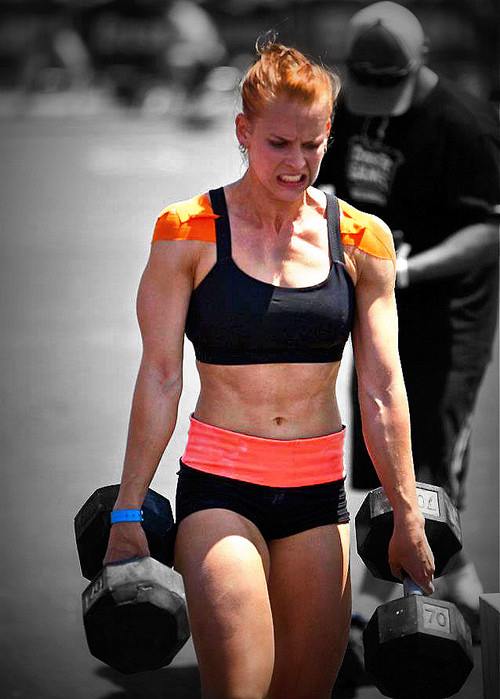
Supertraining author, Mel Siff defined work capacity as “the general ability of the body as a machine to produce work of different intensity and duration using the appropriate energy systems of the body.”
The Crossfit Journal has also described it as “ the ability to perform real physical work as measured by force x distance / time (which is average power).
You can also think of it as the total amount of work you can perform, recover from, and adapt positively to.
The farmers walks are a great way to improve conditioning, work capacity, and mental toughness. By putting the body under load for an extended period of time, in a good position, they create pressure in the chest and abdomen, challenging your breathing.
Including the farmers carry in your training will provide you with one of the best work capacity and conditioning tools that can be implemented in almost all training programs of all fitness levels.
A quick side note on breathing: I am not going to turn this into a breathing article, but just understand that you MUST own your breathing during the farmers carry, or else you will not be able to carry weight very for nor will you experience the wonderful benefits of the carry. So, focus on your breathing!
Increased Core Strength
A big reason that I like the farmer’s carry is that it is self-correcting. Meaning if your core is not working right, you will know quickly with the farmer’s carry. You need to have a stiff and rigid spine to allow a nice upright postural position. If you want to improve your core strength and posture, hang onto some weight, stand tall and walk.
I am a big fan of the work of Dr. Stuart McGill. He has done a ton of research on core function and the spine. Some of his research has shown farmer’s walks and other loaded carries are great exercises for training the abdominal wall, external obliques, quadratus lumborum that help create stability in the trunk (2,3). This is in part due to having more efficiency of allowing the muscles of the trunk to brace, allowing for greater stiffness and fewer energy leaks.
Increased Shoulder Health
You can do all of the rotator cuff (RTC) strengthen drills you want, but you won’t be training the RTC like it is supposed to be trained. The main function of the RTC is to stabilize, and loaded carries do just that.
In Dr. Charlie Weingroff’s fantastic DVD, Training = Rehab, Rehab = Training, he discusses how he uses heavy loaded farmer carries to improve shoulder function. Farmer carries help put the shoulder blades into a stable position and stimulate a proprioceptive neuromuscular facilitation (PNF) response to the RTC muscles. This helps create a better position for the shoulder girdle area, helping it become stronger and more stable. He also notes that you need heavy weight to do this, so don’t use a small amount of weight on these. Load it up!
Variations Of The Farmers Carry
the farmer’s carry is a functional exercise that has numerous variations to target different aspects of strength, stability, and endurance. Here are some popular variations:
- Traditional Farmer’s Carry: The standard form where you hold a weight in each hand and walk for distance or time. It’s great for building grip strength and total-body stability.
- Suitcase Carry: This is a single-sided version where you hold a weight in just one hand, forcing your core to work harder to maintain balance.
- Overhead Carry: Holding the weight overhead increases the focus on shoulder stability and core strength. It’s more demanding than the traditional version.
- Rack Carry: Hold kettlebells or dumbbells at your shoulders in a “rack” position. This works the core and upper back while also hitting the legs as you walk.
- Zercher Carry: The weight is held in the crooks of your elbows. This shifts the focus toward your biceps and front deltoids and is a bit more taxing on your upper body.
- Trap Bar Carry: If you have access to a trap bar, you can perform a farmer’s carry by walking with it. This may be more comfortable for some people and can allow for heavier loads.
- Bottoms-Up Kettlebell Carry: Holding a kettlebell upside-down by its handle targets forearm strength and wrist stability.
- Slant Walk: Holding one heavier weight in one hand and a lighter one in the other can challenge your body’s ability to stay balanced, hitting your core from a different angle.
- Yoke Carry: Though not strictly a farmer’s carry, the yoke carry involves carrying a yoke across your shoulders, which also works your core, shoulders, and legs.
Each variation has its own set of benefits, so incorporating multiple types into your training can offer a well-rounded approach.
Carry On
In the strength world, there is a funny saying us meatheads use when people ask us how to get strong and build muscle. We simply say pick up heavy weights and then put them back down. It sounds simple, but it is true and it works. The farmer’s carry can be used for many training goals. Burn fat, build muscle, and increase conditioning, coordination, athleticism, rehab and performance. So as you can see, we all can benefit from carrying around some weight with good posture, proper breathing and heavy loads.

Justin Grinnell is a Certified Strength and Conditioning Specialist, as well as a Certified Personal Trainer,and a Crossfit Level 1 Trainer. He is also the Owner of State of Fitness in East Lansing, Michigan. State of Fitness opened up just four years ago and is already one of the leading training facilities in the Midwest. State of Fitness has over 450 members who train every day under his leadership. In addition to being a facility owner, Justin has his own blog at www.grinnelltraining.com (link below), and has been a featured writer for over 6 years in the magazine Healthy & Fit and is a writer for Muscle & Fitness.
References:
-Ghigiarelli et al (2013). Effects of Strongman Training on Salivary Testosterone Levels In a Sample of Trained Males. Journal of Strength and Conditioning Research, 27(3), 738-747.
-McGill et al (2009). Comparison of Different Strongman Events: Trunk Muscle Activation and Lumbar Spine Motion, Load, and Stiffness. Journal of Strength and Conditioning Research , 23(4), 1148-1161.
-McGill et al (2012). Kettlebell Swing, Snatch, and Bottoms-Up Carry: Back and Hip Muscle Activation. Journal of Strength and Conditioning Research , 26(1), 16-27.

